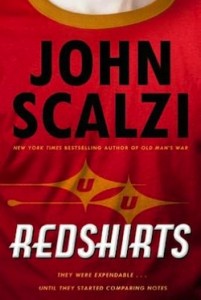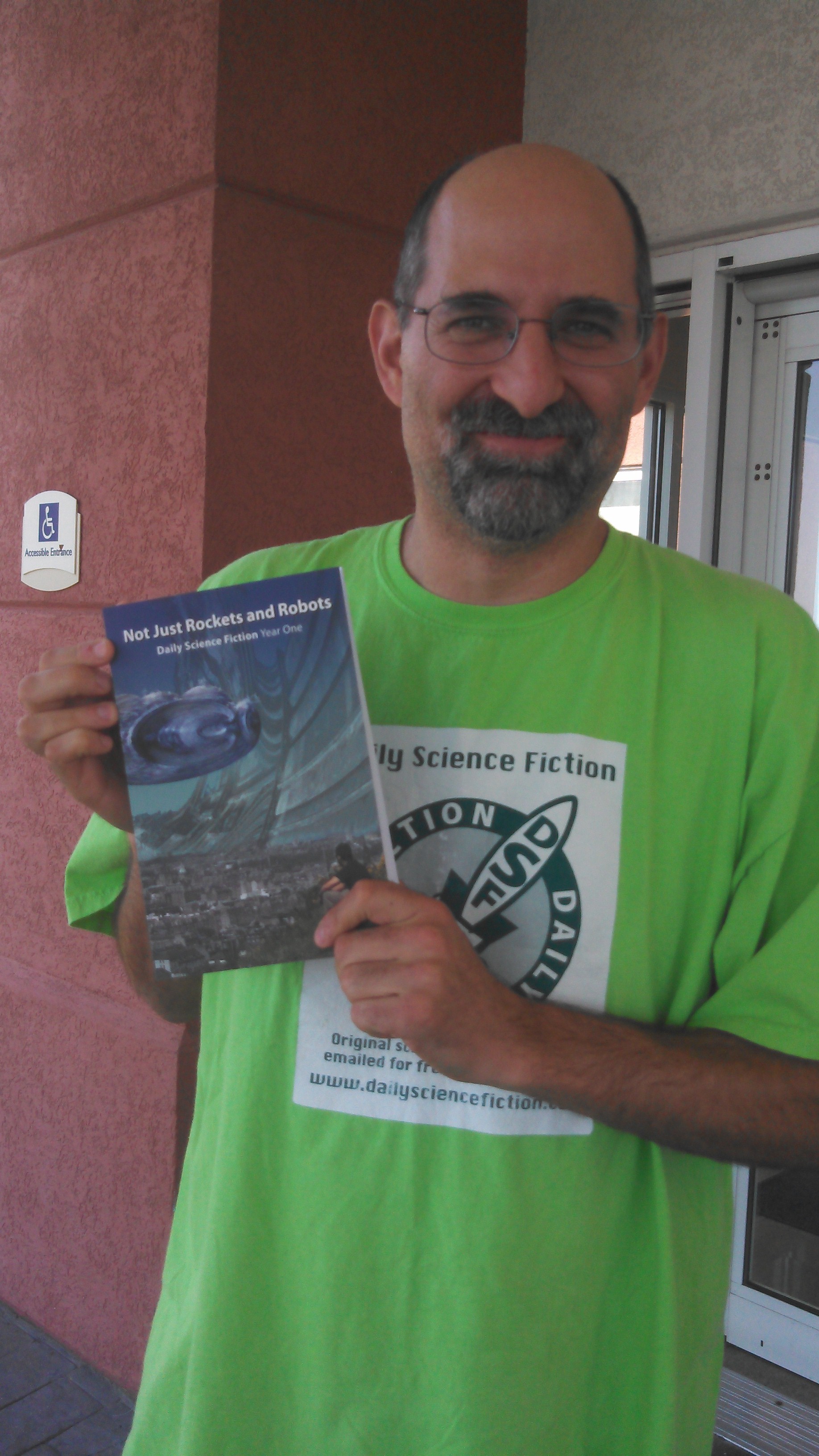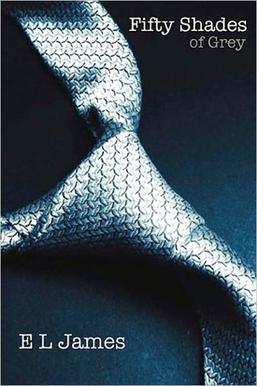written by Frank Dutkiewicz
It is, at the time of this writing, the weekend after Thanksgiving. This is the first time I’ve managed to complete my monthly review of Daily SF in under a month of the last story’s debut. Hooray for being current! But enough of my self-congratulatory back-patting, let’s look at something that deserves real praise†�
Darcy believes in her men in “Mama’s Science” by Shane D. Rhinewald (debut 10/1 and reviewed by Frank D), but Mama warns her not to misplace her faith in such an unreliable creature. Darcy’s father leaves for the stars when she is just five. Bitter, she blames her cynical mother for driving him away. Thus begins a lifetime of head-banging between the two as Darcy builds and shatters relationships.
“Mama’s Science” is a tale of a girl who can’t pick a good man to save her life. Her mother is the pessimistic one, predicting failure and disappointment whenever a man springs on the scene. The story is a commentary that Darcy was in search of support when she needn’t look no further than her mother. But to me, Darcy’s mom hardly comes off as a supportive parent. In the real world, cynical views of the opposite sex from a parent will have a negative effect on a child’s future relationships and I can’t help but to wonder if this was one of the reasons why Darcy couldn’t keep (and pick) a good man.
A woman falls for a merman in “What the Sea Wants” by P. Djeli Clark (debut 10/2 and reviewed by Frank D). The protagonist is greeted by a young boy with deep black eyes, once again. He is beckoning her to rejoin him in the sea, a request she was unable to deny several times before. But she is now an old woman, and memories of the people she hurt before, steel her from his charms.
“What the Sea Wants” is a tale of time and evolving legend. The protagonist first met the merman when she was a child, diving into the deep blue off her father’s boat when she became mesmerized by the boy’s dark eyes. She is drawn back to shore where she learns much time has passed and a legend of her disappearance has a risen. The merman returns after many years, pleading for the protagonist to return with his alluring eyes.
I found “What the Sea Wants” to be an enchanting tale. The conflict of desire versus obligation plagues the stories heroine. Each time she returns to the shore, a fresh legend of her disappearance, and knowledge of the broken lives she shattered when she left, is there to greet her. The merman always comes back, years later, to reclaim her. The story is sound and gripping but the ending is a dark one. Well worth the time for a quick read.
“Not the Destination” by Richard E. Gropp (debut 10/3 and reviewed by Frank D). Protagonist embarks on trip in space and takes the slow route.
“Not the Destination” is very brief and left me full of questions. It is not known if his motives are for solitude or scenery. Not knowing made the story unsatisfying for me.
Kelley accepts the only thing her mother wanted to protect in “Scraps” by Michael Haynes (debut 10/4 and reviewed by Frank D). Her chain smoking mother has passed away, not done in by cigarettes as Kelley predicted but in the horrible fashion of a house fire. She is handed a small fireproof safe, the only thing to survive the blaze. Inside is an item that was a bone of contention in their relationship, a dollar store scrapbook her mother gave her for a Christmas gift. Inside the pages are mementos of heartbreaking events in their relationship , programs to a school concert Kelley played in, a cast list to spelling bee her mother never made it too, and such. The book revives bitter memories Kelley would just as soon forgot but these little scraps have memories of their own.
“Scraps” is a tear jerker of a tale. Kelley remembers a mother who was rarely there for her. Kelley believed her mother threw the book away after her fit when Kelley opened the gift. Other bitter memories surface as she thumbs through it, but when her hand brushes against one of the items a new vantage point of an event flashes in her head; memories that belong to her mother.
The first half of “Scraps” is of Kelley’s recollection of her relationship with her mother. In her eyes, mom was an irresponsible parent. The author does an excellent job of getting the reader to sympathize with Kelley, but as in most contentious relationships, there is another side, and we get to see it. The story is a reflection that many people who have lost a loved one who were difficult to love can identify with.
I found “Scraps” to be a wonderful story. The only gripe I had with it was the disconnected perspective the author used. The 2nd person perspective gave the story an extra layer of distance when the premise deserved a close and personal one. It dulled some of its emotional impact. It robbed a very good story from becoming a rare jewel of the ages. Nevertheless, “Scraps” is a must read.
Recommended.
Jiao needs to know more about a nerd’s magic coat in “Nathan and the Amazing TechnoPocket NerdCoat” by K J Kabza (debut 10/5 and reviewed by Frank D). Attractive, she has been propositioned by geeks before, but when Nathan pulls out a teapot too big to hide in his coat, out of a pocket, she agrees to meet him after work.
“Nathan” is a tale of a curious waitress and man who is hiding more than storage closet’s worth of items in his coat. Jiao is sure the Ichabod Crane-ish man isn’t being honest with her when he claims his teapot trick was just a sleight-of-hand ruse. She isn’t buying his denials as his story keeps changing and the amount of things coming out of his coat keep growing. Her curiosity becomes horror when a hand reaches out of one of the pockets.
I found the story long in development but with a satisfying twist in the last half of the tale. I hesitate to write more so as not to spoil the story for those who haven’t read it but I will say the ending had a nice poetic justice finish to it.
An alien is losing her mother again in “Blue Sand” by Caroline M Yoachim (debut 10/8 and reviewed by Frank D). The protagonist is a squid-like creature. She has just pushed her mother’s corpse into the sea where it can live a happy afterlife and visit her when the tide is low. She becomes concerned when the blue sand covering the beach is showing signs of change. The aliens from Earth have come to take the sand , as souvenirs and to use as glass , and now her mother and the other ghosts are beginning to fade.
The aliens of “Blue Sand” have a unique connection to their ancestors. The blue sand that lines the beaches are the broken down remnants of the departed. The protagonist can visit her mother skittering on the surf and talk to her. Strange pebbles of green slivers first begin to appear then the blue sand slowly begins to be replaced by white. Her mother is disappearing, and this time for good.
“Blue Sand” is an environmental message wrapped within a Far Eastern mythological theme. The unseen humans cannot see the ghosts and have no idea what they are doing to the life on this world. The protagonist is powerless to stop them but has a connection too strong to allow it to be abandoned. Well told. I liked the ending.
Renan paints for his master in “Caput Mortuum” by Andrew Kaye (debut 10/9 and reviewed by Frank D). He is a dim man who can see colors outside ordinary people’s viewable spectrum. He paints what he can see for his master, a trait that aids his master’s experiment.
“Caput Mortuum” is told from the perspective of a mentally challenged man. He can see the remnants of magic. His talent is crucial to his employer , Esteban Soliente , as he works to develop an armor to protect ordinary men against magical weapons.
The author of this tale did a wonderful job writing from the perspective of a clueless protagonist. Esteban is working on a revolutionary protective gear that could tip the balance of power, which makes him dangerous to many. The reader is in the unique position of knowing more than what the protagonist can grasp. Difficult to do, masterfully done.
Each day the postman delivers a piece of life lost along the way to an old man in “Lost and Found” by Jamie Todd Rubin (debut 10/10 and reviewed by James Hanzelka). The young caregiver watches as each is delivered and relished as the old man comes to remember things long forgotten. It is the week in a life of all of us at some point in time. A week that will end on a Sunday sometime in the future.
This was very well written. It took a while to get into it, required an investment from me, but the payoff was well worth it. The author did a good job of pulling me into the life of the main character and showing me a bit of his life. As the story moves to its inevitable end, I came to know the man and feel what he felt. Well done.
Commander Thero watches the destruction of the planet from his bridge. In “This is the Way the World Begins” by C. L. Holland (debut 10/11 and reviewed by James Hanzelka), they will need to destroy all life before they can begin reshaping it for their purposes. The Prefector wants his own planet and it’s the commander’s job to give it to him. In spite of some problems with enslaved beings they use to wipe out the world’s population everything is proceeding as planned, or is it?
This is a nice little morality tale. The author set it up nicely, but the plot was a little too obvious. It is still nice to get a little reminder that absolute power, or the illusion of such, can ultimately lead to our own demise. Nicely written and the point is well made. Give this one a read if you’re in the mood for a little twist of fate.
The protagonist is keeping it real in “Shimmer” by Amanda C. Davis (debut 10/12 and reviewed by Frank D). She is an artist in high school. Too many of her other classmates are caught up in the latest craze, shimmer. It is the ability to turn perception into reality. Do you want to be tall and beautiful? Improve your image and your peers will perceive you as so. Trying to become something you are not does not sit well with the protagonist, but a successful artist in this altered-percption world requires a good front for the admirers of art. She must decide if her desire to showcase her vision worth her self-respect.
The protagonist is appalled by shimmering so she becomes disappointed with her good friend, Benjie, when he pastes a photo-shopped image of himself , taller and handsome – in the form of a poster on the walls in school. She wishes everyone could simply be themselves and not the false faÃ�’ �ade that shade people in their lives. An invitation to present her art gets her to compromise her principles. Benjie is put off by her hypocrisy, forcing her to reflect on her decisions.
“Shimmer” is an odd premise. The constant changing perceptions of others morphs the features of people from moment to moment. Why such a technology would be desired is lost on me. The heroine of this tale wins an opportunity to present her work in an art exhibit , a one in ten thousand chance. She wants to look her best for the exhibit (an understandable reaction) but her friend Benjie can’t help but to shove her own words back at her.
“Shimmer” is a tale featuring a deep protagonist in a sea of shallow characters. The story is a commentary on society’s constant need for improvement of self-image at the expense of our own self-respect. An odd set of circumstances brings the protagonist’s love of art at odds with own values, setting up a finale fitting for an artist eager to make a statement. I found the story to be heavy on message, and thought the storyline was stretch. Perhaps readers who remember high school as a cruel place can appreciate the message in “Shimmer”. I for one would sooner forget it.
Gar-gag is out for another conquest in “Trophy Wife” by Samantha Murray (debut 10/15 and reviewed by Frank D). He is after his seventh alien life-giving organ trophy. This new world has a different form of contest, and is out to master the art of the battle the call ‘dating’.
This short tale is a tongue-in-cheek look at the hazards of internet dating. Cute but with a predictable outcome.
“The Chosen One” by Huston Lowell (debut 10/16 and reviewed by Dustin Adams) is a complex tale that debates the contrast of blind faith and scientific analysis. Two men, in their search for the Chosen One, watch a little boy playing and while one man sees signs in everything the boy does, the other suggests caution and further study.
I found myself confused when one man accused the other of being the Chosen One, especially after they’d described the specific conditions the Chosen One need be born under, but I believe that was immaterial to the true purpose of the story, which was the debate mentioned above.
“The New Kid Is No Angel” by James Valvis (debut 10/17 and reviewed by Frank D). The protagonist is having a hard time getting along with a new friend. The two can’t come to an agreement on which superpower is better.
A tongue-in-cheek flash tale of a geeky comic book loving pair. Mildly amusing.
The protagonist attempts to get in touch with her mother in “My Mother’s Body” by Christie Yant (debut 10/18 and reviewed by Frank D). Her mother has succumbed to a horrible but unidentifiable disease. She has the same illness and is taking the action her mother sought.
I confess, I didn’t fully grasp the premise of this piece. The images of what her mother went through are disturbing but I am quite lost at what she is doing to counteract it. It appeared a healthy human being had sacrificed herself for reasons that are unclear to me.
Mark finds his special someone in “Phone Booth” by Holli Mintzer (debut 10/19 and reviewed by Frank D). In a city full of superheroes, an occasional detour in your day from a villain can be expected. Mark’s train is diverted where he meets the girl of dreams, Lisa. The two hit it off and a budding relationship soon follows. She is a guarded woman, often gone on business trips and errands but spends every available moment she has with him. When the world is full of ‘capes’, and villains to keep them busy, disruption in a relationship can be expected, can’t they?
“Phone Booth” is the tale of an everyday man within a world rich in superheroes. Lisa is just the type of girl he has been in search of his entire life; lovely, thoughtful, caring, and with a bit of mystery about her. Their relationship is a slow developing one. Lisa’s friends are wary of Mark and protective of her. Of course, on this world, disaster can strike in any moment.
“Phone Booth” has a premise that is pretty transparent. It isn’t hard to see where the story is headed. It is (spoiler alert) very much like the movie “My Super Ex-girlfriend”, minus the corny and dark humorous component. This story examined what it would be like when you live in a battlefield of good versus evil on grand scale. The author wanted to keep a story with an out-of-this-world premise grounded. Nice tale of a sweet romance set in the most extraordinary settings.
Losing your memory at 30,000 feet can be an experience. In “Don’t Look Down” by Anatoly Belilovsky (debut 10/22 and reviewed by Frank D) the protagonist is a man suffering from dementia. Sky diving is his idea of treatment. Nothing like seeing your life flash before your eyes to spur those old memories into action.
I had to read the author’s comments to understand the concept for this story. I was confused on why he was suddenly hit with amnesia. “Don’t Look” is a tale with a very slight speculative element. It seems to me, he is suicidal and his daughter is irresponsible for allowing him to flirt with death like this.
An introvert enjoys a cup of coffee in a diner. “The Number Two Rule” by Lesley L. Smith (debut 10/23 and reviewed by Frank D) is the tale of a woman who is lost. She spends her time watching an especially cute little girl play in the park every day. She must never interact with anyone. She should be invoking rule # 2, but it is a very difficult rule to follow.
“Number Two Rule” is a story set for a twist. For me to reveal anymore would be revealing too much. I rather liked this tale.
Sam needs to say his final goodbye to his departed wife in “Over There” by Dany G. Zuwen (debut 10/24 and reviewed by Frank D), but is not sure he can face her to do it. Ellen, his wife, died years before but had her essence downloaded. He can see her holo-image in the Room where they can talk but not touch. A depressed Sam met Naomi six years before when he last visited the Room. He plans on visiting Ellen one last time to let her know he found someone new, but discovers old feelings are a hard thing to dismiss.
“Over There” is set in a future where the afterlife is real, made possible with technology. Sam is racked with guilt, and his departed wife’s understanding words only makes it worse for him. She is willing for him to move on.
This tale has quite a poetic ending. Because of her ability to traverse the electronic net, Ellen has kept tabs on her husband. Sam comes off as man who should have invested in on grief counseling. Interesting story. I’m glad I read it.
An origami artist competes without his hands in “Susumu Must Fold” by Tony Pi (debut 10/25 and reviewed by Frank D). Susumu is an origami master who lost his hands in a tragic accident. Cyberneticists were unable to attach arms that would return the digital dexterity he needs for his craft. Entering the hall with one arm and hand covered in a glove, Susumu is out to demonstrate that hope is never lost.
“Susumu” is a tale of perseverance. The origami master must overcome his own limitations and the taunting words of a rival. In his corner are miniscule robots he is mentally connected too. The method of folding is different but art is something that comes from the heart.
I read an earlier version of “Susumu” when it appeared in the writer’s group contest the author referred to in his comments after the story. I thought then that the protagonist had an unfair advantage over his opponents then, just as I do now, but the issue of what is fair play is not the point of this tale. The competition Susumu is not against his fellow competitors but rather against the disability thrust upon him. I feel the message in “Susumu” would have had more meaning if the protagonist had been a painter instead. A story of microbots folding paper just seems too much like cheating to me.
Mia fights the Empty. “A Handful of Glass, a Sky without Stars” by Damien Walters Grintalis (debut 10/26 and reviewed by Frank D) follows a week in the life of a young woman surviving in a post-apocalyptic world. Toxic fumes have poisoned the air, a result of a war fought a generation before. The citizens are devoid of feelings , the Empty. An inhalant combats the condition but its effects fade over the course of a few days. Many chose to end it all before Saturday , the day to regenerate against the Empty. TGIF is now a matter of life and death.
The world of “A Handful” is a depressing lot. The city of which Mia lives is an island of refuge in a sea of devastation. Much of the world is dead. Protestors insist the rest of humanity should follow suit. Mia clings to her fleeting feelings and dreams of the stars her father claimed beyond the dark, polluted sky.
I found it difficult to believe a city like the one in “A Handful” could exist. It is a faÃ�’ �ade; its citizens operating as if their world is still functional, inconceivable when the very air and soil is toxic. The story is an examination on how civilization could continue when hope itself is gone. I am unsure how the drug Mia took could counteract it, or how the government could feed the masses. Viability of the storie’s premise left me with too many questions to give the tale’s message a fair shot.
Caroline is her father’s daughter in “My Mother’s Shadow” by Henry Lu (debut 10/29 and reviewed by Frank D). She is a little girl, one of the cursed born without a shadow. Her mother married a man without one and the trait has been passed down. Shadowless people have been condemned by god and are shunned. Caroline wishes she could be more like her mother, but is too full of resentment to know it isn’t her shadow that makes her mother so special.
“My Mother’s Shadow” is a tale of prejudice. The shadowless people are treated as harshly as the Jewish people were under the Nazis. Caroline misses her father but resents others like her, feeling as if they’re responsible for her misery. The tale is told well in the eyes of a small child who is discriminated for no reason other than sharing a lineage with a cursed race. Her anger is misplaced as she attempts to make sense of the hatred towards her.
Nice but sad story. The ending may have been too open ended for some but I rather liked how it was concluded.
The protagonist has a best friend who is always watching over her in Just Today by Nina Kiriki Hoffman (debut 10/30 and reviewed by Frank D). Ben is a ghost, killed in a hit-and-run accident while they were trick and treating. Usually, he is watching out for her but fails to warn her when the neighborhood bully corners her. It’s too bad Ben can’t help her, but he keeps trying anyway.
“Just Today” takes place while the protagonist as on her way to school. Several images from different movies (A Christmas Story, Ghost, Sixth Sense) came to mind while I was reading this, making it feel as if the author borrowed heavily with the premise as she wrote it. The story drifted and the plot had trouble remaining grounded. Cute idea but the incomplete ending and jumbled storyline lessened the enjoyment of the story for me.
Little Red Riding Hood boards the bus to Grandma’s house in “Red at the End of the World” by Lynda E. Rucker (debut 10/31 and reviewed by Frank D). This darker version of a famous fairy tale begins very un-fairy tale-ish. The famous Red’s attempts to remain low key are foiled by a blabby bus driver. A cute young man , Snow White , attaches himself to her and the pair embark on the journey to granny’s together.
“Red” is a strange retelling of the legendary Grimm classic. It took a good third of this tale for me to realize who the protagonist was. Red takes an instant liking to Snow White (how SW became a he is beyond me) and is expecting the grisly scene when she arrives at Grandma’s.
I confess, I have no idea what point the author was trying to make in this story. I found the needless sub-plots , the Snow White character, unexplained references to anarchistic events, grisly scenes of violence , to be distracting and head-scratching to their relationship to the rest of the story. Particularly puzzling was the ending. It alluded to a larger backstory. Instead of a creepy ominous feeling of dread I think the author was after, it left me shrugging my shoulders in indifference.
Helping to fertilize a grass roots movement†�
If there is a person who has the capability to generate a buzz via the web in the closed universe of speculative fiction writing, that person would be John Scalzi. If you don’t know who he is, then you don’t read enough science fiction. His acclaimed novel, Old Man’s War has been in every Best Science Fiction Novel list I have taken the time to read. His latest novel, Redshirts, debuted at number 15 on the New York Times hardcover fiction best sellers list. To list all his accomplishments would likely force Dave to get out his scissors and preform a rare edit for one of my reviews. So to summarize, John Scalzi is one popular guy.
His blog, Whatever, gets a lot of web traffic (as Diabolical Plots once discovered a couple of years back in a redirected link from Mr Scalzi, thank you very much, sir). With a daily visitor rate in the neighborhood of 50,000, John has been all too willing to share his vast network of followers for the up and coming writers. One way he has done that is with an Award Awareness Post. For two years running, he has given authors and editors the opportunity to promote their works for consideration for the Hugo’s. The thread is very long (205 comments) but I was delighted to find a good 7 or more authors mentioning their Daily SF stories as candidates (some of them I felt were worthy). At the tail end of the long lists of posts, you will find DSF editor Jon Laden’s own list of stories he felt were deserving.
Did any of them get nominated? Sadly, no, however, making the long list for Hugo’s Best Semipro Magazine, was Daily Science Fiction. Although it only garnered 5% of the vote, it beat out several publications that made the short list in the past. Not bad for an often ignored , but innovative , email publication.
Thanks to the voting members who wrote in the magazine. Hopefully, they’ll get DSF to crack the top five next year (not an easy feat when you see who they’re up against). And hopefully, Jon and Michele will make the editor’s category next year.
 Have you ever watched an old Star Trek episode and thought it would suck to be the guy wearing a redshirt on an away mission?
Have you ever watched an old Star Trek episode and thought it would suck to be the guy wearing a redshirt on an away mission?
John Scalzi’s Redshirts: A Novel with Three Codas is a novel for you. This New York Times bestselling ‘soon to be classic’ is a tale of a young redshirted ensign assigned to the Intrepid, where wearing the redshirt on an away mission is a death sentence. To learn more, visit macmillan.com

 I have been a loyal fan of the Final Fantasy series of games for a long time. I played the original Final Fanasy on my brother’s NES. The first one in the series I really got into was Final Fantasy VI which I knew as Final Fantasy III in the American numbering scheme, released for the Super NES in 1994.
I have been a loyal fan of the Final Fantasy series of games for a long time. I played the original Final Fanasy on my brother’s NES. The first one in the series I really got into was Final Fantasy VI which I knew as Final Fantasy III in the American numbering scheme, released for the Super NES in 1994.





 The book Fifty Shades of Grey by E.L. James has been mentioned in many many different media sources over the last year, to a much larger degree than most books get attention. Now, this happens periodically with books that gain some mainstream appeal, like Dan Brown’s Da Vinci Code and, Stephenie Meyer’s Twilight series, and JK Rowling’s Harry Potter series. I didn’t really know what kind of book this particular one was until I saw a Saturday Night Live fake Mother’s Day commercial, wherein various families come home to give their mom breakfast in bed or other traditional gifts, and find her in bed, in the bathtub, or in the laundry room masturbating, causing much embarrassment on everyone’s part. Ah, erotica.
The book Fifty Shades of Grey by E.L. James has been mentioned in many many different media sources over the last year, to a much larger degree than most books get attention. Now, this happens periodically with books that gain some mainstream appeal, like Dan Brown’s Da Vinci Code and, Stephenie Meyer’s Twilight series, and JK Rowling’s Harry Potter series. I didn’t really know what kind of book this particular one was until I saw a Saturday Night Live fake Mother’s Day commercial, wherein various families come home to give their mom breakfast in bed or other traditional gifts, and find her in bed, in the bathtub, or in the laundry room masturbating, causing much embarrassment on everyone’s part. Ah, erotica.